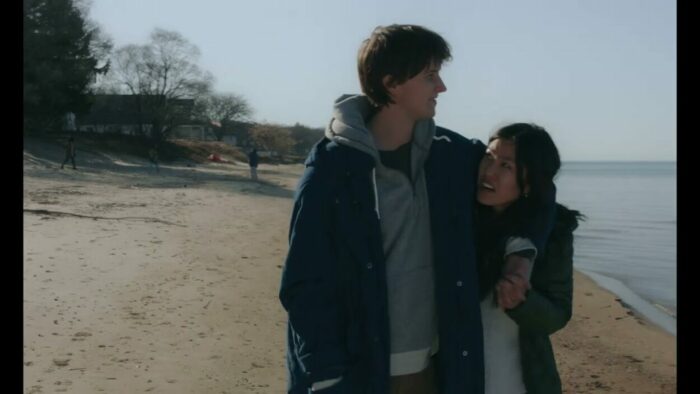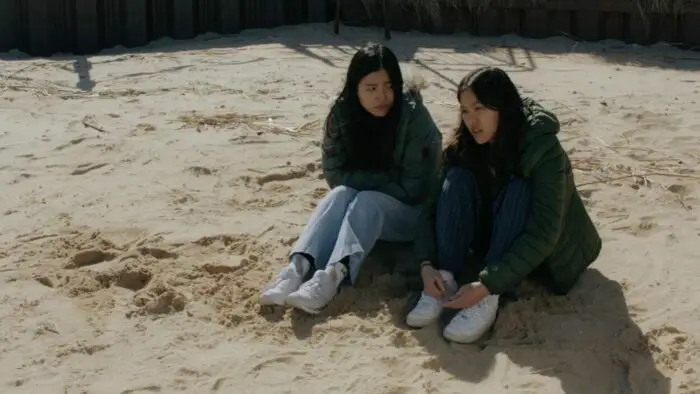Life is simultaneously complicated, complex, and beautiful. Humans do their best to navigate the ups and downs, uncertain of what might happen next. After all, there are no set instructions about how to live or directions on where to go. Linh Tran’s Waiting for the Light to Change is a moving and thoughtful exploration of loneliness, grief, love, identity, and searching for something more. The film’s title suggests that the characters are confronted with a sense of aimlessness and an anticipation of how their individual stories will unfold.
In its premise, twenty-something Amy (Jin Park) is invited to a week-long seaside vacation, accompanied by her best friend, Kim (Joyce Ha), Kim’s boyfriend Jay (Sam Straley), her cousin, Lin (Qun Chi), and Jay’s friend, Alex (Erik Barrientos). After recently experiencing significant weight loss, Amy struggles with her loyalty to Kim while grappling with a deeply rooted attraction to Jay.
Set in a sleepy town on the Michigan coast, Waiting for the Light to Change stunningly showcases the peaceful sanctity of nature as a backdrop for the characters’ contemplation and reflection. The lighting is naturalistic and raw, beautifully captured in the shots of water gently lapping on the shore and the sweeping, isolated beach landscapes. There’s an innate melancholy and dread in the surroundings gorgeously encapsulated in the performances from a talented cast whose unwavering instincts and resonant emotion carry the film’s weight.

In such a dreary winter setting, there’s nothing to do except take long walks on the beach and stare into the vast distance where everything appears unknown. Glimmers of each character’s pasts, fears, dreams, hopes, and anxieties about what the future holds manifest in dialogue that’s realistic for adults in their early-to-mid twenties. Tonally and story-wise, Waiting for the Light to Change is nearly reminiscent of Richard Linklater’s filmography (specifically, Reality Bites and Before Sunrise).
One scene features a heartfelt conversation between Amy and Lin, who is visiting America from China. They are sitting in a bedroom talking about first loves and long-distance relationships—it feels as if it was plucked right from a Linklater film. Amy reveals: “Maybe it’s better to just long for something than to actually have it,” to which she is presumably referring to her longing for Jay. The sensitive dynamic between the actresses comes across eloquently, with the camera positioned far enough that it’s almost as though someone else is eavesdropping on such an intimate and private moment. In the tender and somewhat somber scenes Amy has with Kim, that same sensation is evoked through the naturalistic dialogue.
Co-written by Tran and two fellow writers, the script for Waiting for the Light to Change mirrors personal events that happened to her, making the characters even more truthful depictions of real people at seemingly similar yet different stages in their lives. By a cosmic happening of fate, these twenty-somethings were brought together at this special point in time as they ponder their place in the world—an inevitable symptom of getting older. Pursuing a career they’re passionate about, finding what they love to do, and figuring out who they want to be are questions that might not get answers for years and years, if not longer. Escaping from reality to think about these big concepts might not be what they truly need.

Empty space encompasses most of the frames. The physical distance between characters speaks volumes of what’s not verbally conveyed. Things that want to be said don’t come to fruition, even if they are close. Although Kim and Amy haven’t talked for a long time and grew apart after high school, they care immensely for each other. Sometimes, the closest friends go their separate ways, and for underlying reasons, one might consciously remove themselves from the friendship before the other gets hurt. Such is the painful process of growing up and confronting one’s own demons.
While not much happens in Waiting for the Light to Change, that’s where its magic lies—in the ordinary and every day. The actors bring a grounded presence in every scene, producing an effectiveness that’s not forced or disingenuous at any point. They aren’t merely characters on a screen but living, breathing humans trying to figure out themselves. There is an effortless cadence to how the film unfolds, which is masterful in a unique way. The subtle tension from its beginning comes to a slight head towards the end, yet much remains unresolved as the credits roll.
As an impressive feature film directorial debut for Tran, Waiting for the Light to Change is a nuanced portrayal of lost souls coming to terms with change and uncertainty as they navigate the unpredictable course of their lives.


